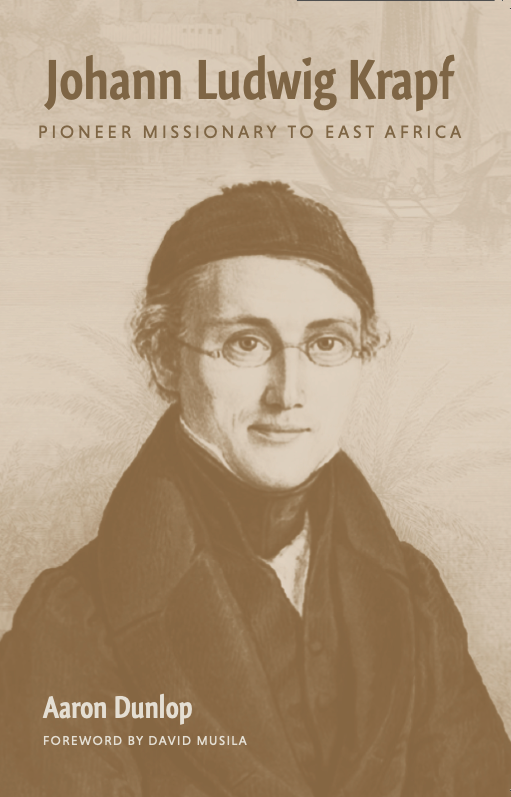For many East Africans, the name Johann Ludwig Krapf is as strange as it is antiquated. Moreover, for some, it conjures up the stereotypically negative image of a European who opened up East Africa to colonisation. As the first missionary to enter Kenya, we were required to study about him in our history class. His was one of the many short paragraphs in our primary school history books that described the pioneering Western explorers.
In this brief and captivating biography, Aaron Dunlop captures the heart of the man behind that strange name. Dunlop details the pains and joys of the 19th-century pioneer missionary to what was then known as the “Dark Continent.” He uncovers the individual beneath the explorer label, revealing Krapf’s heart for unreached people, people for whom he sailed from Germany to East Africa. He reveals Krapf’s sufferings to reach the unreached people of all nations with the good news of Jesus Christ.
Krapf’s Heart for the Unreached People of East Africa
Dunlop’s book traces Johann Krapf’s early life, conversion, and aspiration to join missionary work. It recounts how God providentially delayed his eagerness to step into the mission field to prepare him further. Additionally, it shows how God ultimately opened doors for his missions through the Christian Mission Society (CMS) to a different world.
The challenges Krapf faced in evangelising the Oromos were insurmountable.
Krapf’s heart was set on the Oromos of Ethiopia, as he was convinced they would play a crucial role in evangelising the inland of Africa. However, his missionary journey to Ethiopia was marked with strife and resistance from the start. During his time in Ethiopia, Krapf endured hardships due to the opposition of various warring tribes, the unforgiving terrain, and the harsh weather. Robberies, diseases and betrayal marked most of Krapf’s five years in Ethiopia. These years were also marked by the blessing of his first marriage and the tragic loss of his firstborn daughter at birth. He encountered additional resistance from the Roman Catholic missionaries and the indigenous Orthodox churches.
Eventually, CMS relinquished its efforts in Ethiopia. The challenges Krapf faced in evangelising the Oromos were insurmountable. CMS was prepared to send him to another mission field, Asia. But Krapf pondered how he would answer to God on Judgment Day if it turned out that he had not done everything necessary to spread the gospel in Africa.
Johann Krapf’s Perseverance and Divine Providence
Krapf still resolved to reach the Oromos by what he thought would be an easier route from the south of Ethiopia. Little did he know then that God was sending him to a different people among whom he would have an even more significant impact. His missionary work would eventually open East Africa to the rest of the world.

Johann Ludwig Krapf: His Life and Legacy
Aaron Dunlop
Johann Ludwig Krapf: His Life and Legacy
Aaron Dunlop
This biography provides an introduction to Johann Krapf’s life. It details his early flirtation with Christian mysticism and the development of a practical and passionate heart for the unreached Oromo people of East Africa. It follows his strategic missionary manoeuvring and his indomitable courage and fortitude in the face of repeated setbacks. His story reveals a profound faith in the sovereignty of God and the nature of his mission in the world.
Having travelled south via the Red Sea, he soon established a mission station in Rabai on the Kenyan coast. He aimed to set up a network of mission stations across Africa connecting the Indian and Atlantic oceans. Although Krapf’s ambitious plan did not materialise during his lifetime, he successfully introduced Christianity to East Africa.
Krapf lost everything for the gospel.
As in Ethiopia, Johann Krapf’s work along the Tanzanian and Kenyan coasts, as well as his journeys inland, were marked by blood and tears. He gave up his strength and youth to the expansion of the gospel in this region. One cannot help but think of him as a man with superhuman strength, given the suffering he endured and the tenacity with which he continued his work. A poignant moment in the book occurs when, while in Rabai, he loses his wife after she has just given birth to a healthy little girl. He himself faced death, bedridden and unable to care for his dying wife. His daughter died a few days later. He indeed lost everything for the gospel.
Johann Krapf’s Enduring Legacy in East Africa
Krapf welcomed other missionaries who worked with him in the mission field and subsequently ventured further, accomplishing part of his aspirations. His efforts in documenting the Kiswahili language and various other Bantu dialects were also major highlights of his missionary work. The translations of the Bible he produced constituted the premier written texts in these languages.
Krapf trained missionaries and translated the Bible into various languages.
One of the highlights of Johann Krapf’s life occurred in 1850, 13 years after he set out for Ethiopia and six years after arriving in Mombasa. Mringe, his first convert, was baptised at Rabai. The fact that a soul could hear the gospel, believe, and publicly demonstrate that faith is what had brought Krapf to Africa.
Dunlop recounts Krapf’s later life outside of missionary work, including his training and sending of missionaries and his ongoing translation of the Bible into the various languages he encountered in East Africa.
Lessons From Krapf’s Life and Legacy
Dunlop’s biography of Krapf is more than merely a brief paragraph in our history books. To every believer, it is a story about suffering and suffering well. Krapf’s suffering did not hinder his mission to share the gospel of Jesus Christ among the unreached people of East Africa.
Johann Krapf’s story is also about love. He traded his people, a career and a comfortable life for those whom the Western world would have called savages, aiming to reach them with the gospel. A stone was erected on the grave of his wife “to remind the wandering locals that here rested a Christian woman who had left father, mother, and home for the salvation of Africa” (p48).
The story demonstrates Krapf’s obedience to God. He was convinced of Matthew 28:19, where Jesus commanded his disciples to go out and make disciples of all the nations. Krapf believed that that was a mission worth living and dying for.
Krapf’s story is about suffering well, love and obedience to God.
For any Christian, and especially African Christians, Johann Krapf’s life and legacy open our eyes to the sacrifices that have allowed us to enjoy the fruits of the gospel we have today. Our church history is built on the backs of men like Krapf, who braved uncertainties, risked their lives, and made great sacrifices to bring the Gospel message to us. Aaron Dunlop’s contribution helps us clear the often murky distinction between Western Christian missionaries driven by a zeal for the gospel and the colonial Europeans who came to colonise the African land. We not only owe to Krapf the linguistic developments he initiated in Swahili and other East African languages, but we also owe our Christian heritage to his beautiful feet (Romans 10:15) and the gospel message they brought to us, who were “once in darkness” (Ephesians 5:8).









